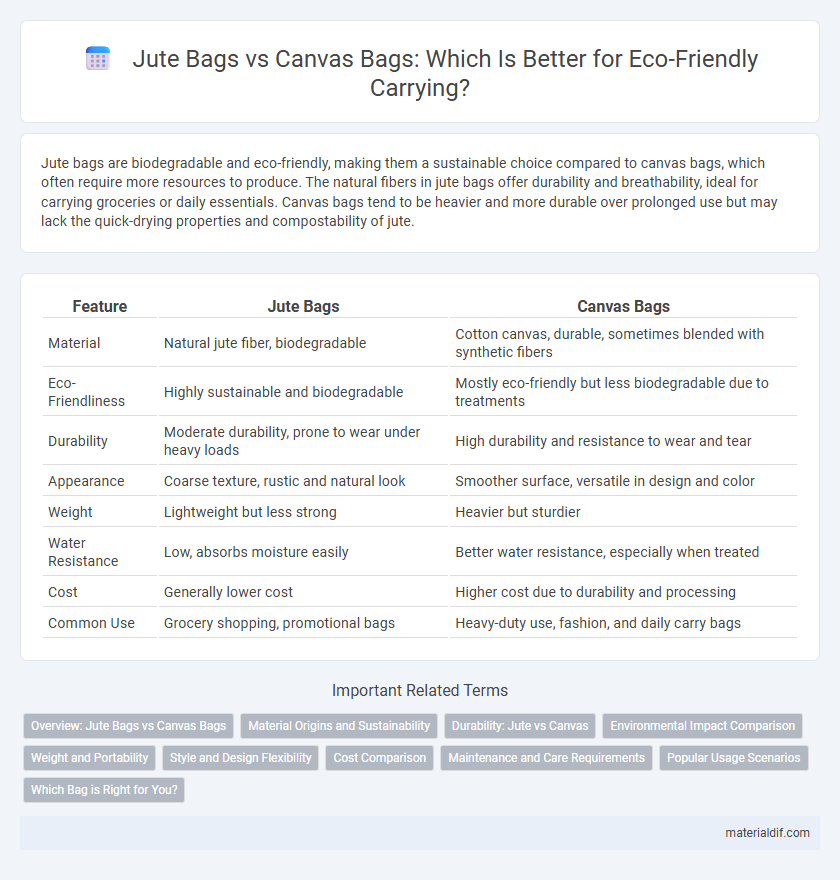Jute bags are biodegradable and eco-friendly, making them a sustainable choice compared to canvas bags, which often require more resources to produce. The natural fibers in jute bags offer durability and breathability, ideal for carrying groceries or daily essentials. Canvas bags tend to be heavier and more durable over prolonged use but may lack the quick-drying properties and compostability of jute.
Table of Comparison
| Feature | Jute Bags | Canvas Bags |
|---|---|---|
| Material | Natural jute fiber, biodegradable | Cotton canvas, durable, sometimes blended with synthetic fibers |
| Eco-Friendliness | Highly sustainable and biodegradable | Mostly eco-friendly but less biodegradable due to treatments |
| Durability | Moderate durability, prone to wear under heavy loads | High durability and resistance to wear and tear |
| Appearance | Coarse texture, rustic and natural look | Smoother surface, versatile in design and color |
| Weight | Lightweight but less strong | Heavier but sturdier |
| Water Resistance | Low, absorbs moisture easily | Better water resistance, especially when treated |
| Cost | Generally lower cost | Higher cost due to durability and processing |
| Common Use | Grocery shopping, promotional bags | Heavy-duty use, fashion, and daily carry bags |
Overview: Jute Bags vs Canvas Bags
Jute bags are crafted from natural fibers of the jute plant, known for their biodegradability and strength, making them an eco-friendly alternative to plastic. Canvas bags, made from durable cotton fabric, offer sturdiness and ease of cleaning, often favored for heavy-duty usage and long-term reuse. Both materials support sustainable practices, but jute bags excel in compostability while canvas bags provide greater durability and resistance to wear.
Material Origins and Sustainability
Jute bags are made from natural fibers derived from the jute plant, which is a renewable crop requiring minimal water and pesticides, making it highly sustainable. Canvas bags typically originate from cotton, another natural fiber, but cotton cultivation demands significantly more water and often involves pesticide use, impacting environmental sustainability. The biodegradable nature of jute fibers contributes to lower environmental footprints compared to the resource-intensive production of canvas bags.
Durability: Jute vs Canvas
Jute bags exhibit impressive durability due to their strong natural fiber composition, resisting wear and tear effectively in everyday use. Canvas bags, made from tightly woven cotton or synthetic fibers, generally offer superior longevity and resistance to heavy loads and frequent washing. Comparing durability, canvas bags often outperform jute bags in terms of strength and lifespan, making them ideal for heavy-duty or repeated use scenarios.
Environmental Impact Comparison
Jute bags have a significantly lower environmental impact compared to canvas bags due to their biodegradable nature and minimal water consumption during cultivation. Canvas bags, typically made from cotton, require extensive water usage and pesticide application, contributing to higher carbon emissions and soil degradation. The sustainable cultivation of jute supports carbon sequestration and reduces plastic pollution, making jute bags a more eco-friendly alternative.
Weight and Portability
Jute bags are significantly lighter than canvas bags, making them more convenient for daily use and easier to carry for extended periods. The natural fibers of jute create a durable yet lightweight material that enhances portability without compromising strength. In contrast, canvas bags tend to be heavier due to their thicker fabric, limiting ease of transport despite their durability.
Style and Design Flexibility
Jute bags offer a natural, rustic aesthetic with limited color options, making them ideal for eco-friendly and minimalist styles. Canvas bags provide greater design flexibility, allowing vibrant prints, various textures, and customized shapes that suit trendy and diverse fashion tastes. Both materials support sustainable choices, but canvas excels in creative expression and versatility.
Cost Comparison
Jute bags generally cost less than canvas bags due to the lower price of raw jute fibers and simpler manufacturing processes. Canvas bags, made from cotton or synthetic materials, tend to be more expensive because of higher material costs and durability enhancements. Businesses and consumers often choose jute bags for budget-friendly, eco-friendly options, while canvas bags are preferred for long-term use despite higher initial investment.
Maintenance and Care Requirements
Jute bags require gentle cleaning methods, such as spot cleaning with mild soap and water, and must be air-dried to prevent mold and fiber deterioration. Canvas bags are more durable in terms of maintenance, allowing for machine washing and quicker drying without significant damage to the fibers. Proper care for both materials involves avoiding prolonged exposure to moisture and direct sunlight to maintain bag integrity and lifespan.
Popular Usage Scenarios
Jute bags are widely favored in eco-friendly markets and grocery stores due to their biodegradable nature and rustic appearance, making them ideal for daily shopping and promotional events. Canvas bags, known for their durability and sturdiness, are popular for heavy-duty use such as carrying books, groceries, and outdoor activities like hiking or beach trips. Both materials offer sustainable alternatives to plastic, with jute bags preferred for lightweight carrying and canvas bags chosen for long-term, versatile use.
Which Bag is Right for You?
Jute bags offer excellent biodegradability and durability, making them ideal for eco-conscious consumers seeking sustainable, lightweight options for everyday use. Canvas bags, crafted from heavier cotton fabric, provide superior strength and long-lasting reusability, perfect for carrying heavier items or daily groceries. Choosing between jute bags and canvas bags depends on your preference for environmental impact, bag weight, and intended usage frequency.
Jute Bags vs Canvas Bags Infographic

 materialdif.com
materialdif.com